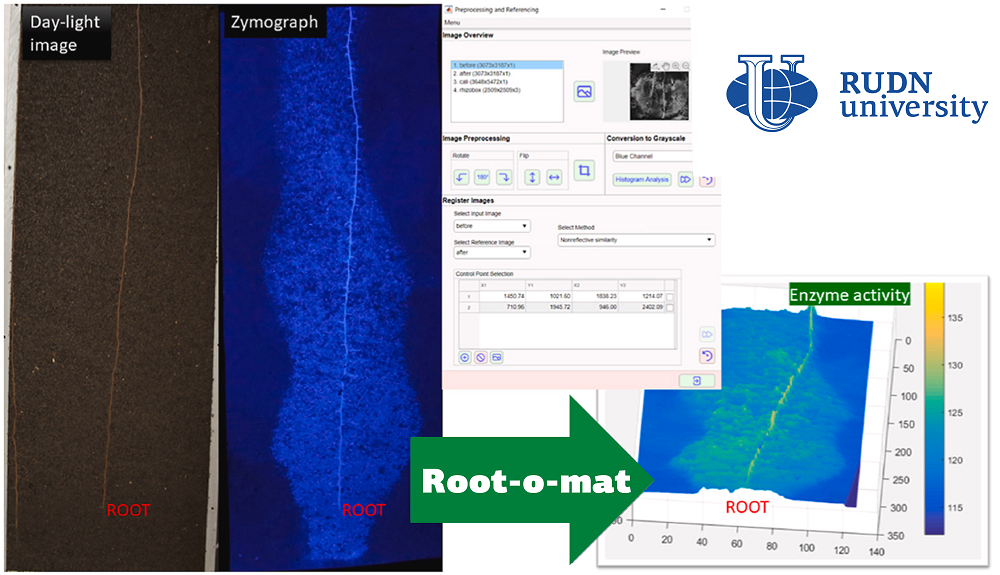RUDN University soil scientist created the Root-o-mat program for processing data on enzymes in the soil
Zymography is an electrochemical method that soil scientists use to analyze the activity of enzymes in the soil. It uses fluorescent substances that glow when interacting with the enzyme. The result is a zymogram — a “snapshot” of the enzymatic activity. However, scientists have started using zymography intensively relatively recently and have not yet developed standards for processing results. Therefore,itmay be difficult for researchers from different research groups to compare their results. RUDN University soil scientist together with colleagues from Germany created the Root-o-mat software, which is designed to solve this problem-to standardize and simplify the processing of zymography results зимографии.
“Most studies on зимографииsoil zymography differ in terms of pretreatment and posttreatmentmethods Например, such as изображения grayscale conversion,imageегистрclassification, or segmentationнтации изображения. This compromises the comparability of the results. Wedeveloped the application to facilitate practical applicability and speed up the workflow of image processing”, — Doctor of Biological Sciences YakovKuzyakovis a leading researcher at the Center for" Smart Technologies for Sustainable Urban Development in the Context of Global Changes " of the RUDN University.
The program algorithm includes several steps. The first one is image registration. It is, used to compare images obtained, for example, at different times or by different devices. At the second stage, the program calibrates the data-brings them to one standard and translates physical quantities to one unit of measurement. The third stage is segmentation. The image is divided into separate groups of pixels that reflect individual objects. At the output, the user receives data ready for analysis in various formats—2D and 33D images, histograms, statistics, and so on. ProgramA is available for free download.
Почвоведы RUDN University soil scientists tested the algorithm in an experiment to determineили, how активностьthe activity of soil hydrolytic enzymes changes before and after adding glucose. The researchers obtained a zymogram of a soil sample with sprouted maize seeds, and also took a photo of a section of the sample. The sample was taken in an arable field near Göttingen (Germany). The soil scientists then added glucose to the soil and repeated the measurements. Glucose supplementation should increase the amount of the enzyme leucine aminopeptidaseы. The resulting data was uploaded to Root-o-mat, which mappedit to a and translatedit into a standard format. Получились Detailed graphs were obtained showing how the leucine aminopeptidase activity changedы before and after glucose addition, and at which points in the sample it was most active.
“Root-o-mat is a set of ready-made interactive tools for creating, visualizing, editing, processing, analyzing, loading and saving data. It includes a graphical user interface that simplifies and accelerates 2D image processing and spatio-temporal analysis — , such, as visualizing the distribution of enzyme activity. The results allow us to estimate временноеthe temporal and spatialое распределение distribution of enzyme activity at the maize root-soilinterface ”, - Doctor of Biological Sciences YakovKuzyakovis a leading researcher at the Center for" Smart Technologies for Sustainable Urban Development in the Context of Global Changes " of the RUDN University.
The results are published in the journal Soil Biology and Biochemistry.
Products derived from microalgae represent a cutting-edge development in the field of bioeconomy. The potential of this biological resource was discussed at the international research seminar “Foundations for a Green Sustainable Energy”, part of the BRICS Network University’s thematic group on “Energy”. The event was organized by the Institute of Ecology at RUDN University.
Ambassadors of Russian education and science met at a conference in RUDN University to discuss how they can increase the visibility of Russian universities and research organizations in the world, and attract more international students in Russia.
The international scientific seminar hosted by RUDN Institute of Ecology “Experience of participation in student organizations as a way to form career skills” united scholarship recipients of the International Student Mobility Awards 2024 and Open Doors, along with members of the scientific student society “GreenLab” and the professional student association “Kostyor (Bonfire)” shared their projects focused on environmental protection.
